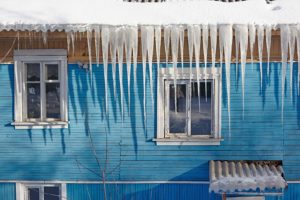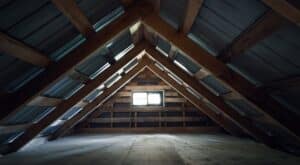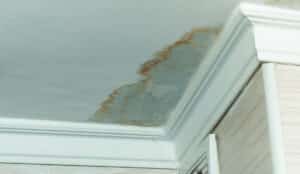What do icicles hanging down and roofing insulation have in common?
Hanging from the roof of that picturesque ski chalet in the mountains, icicles can be quaint and charming. Dangling from your home here in Michigan, not so much. Why? Because, while you might think they’re pretty, they are just a sign of wasted heat.
Icicles form when warm attic air melts the snow on your roof. That melted snow runs down the roof into your gutters. And once it’s no longer on the warm roof, the water freezes again. The more water there is running down over the ice, the more ice buildup you are likely to have.
Icicles are just part of the problem.
If it were just a matter of wasted heat, that would be one thing. Unfortunately, the more ice buildup there is, the more likely it is to cause an ice dam – a ridge of ice that prevents the melting snow from flowing down the roof. Ice buildup can push up under the shingles creating all kinds of problems.
Damaged shingles mean costly repairs. (And in the meantime, your roof is not protecting your home the way it is supposed to.)
The warm attic air continues to melt snow and ice which now seeps under your roofing materials and into your attic. (A possible precursor to mold and mildew problems in your attic.)
The cost of living is high enough in West Michigan. So, let’s talk about how to solve your icicle problem.
Roofing Insulation in the Attic
The purpose of attic insulation is to keep the heat inside your house and the cold air outside. Increasing the R-value of your insulation will keep your home warmer and reduce snowmelt due to a warm roof. The recommended R-value for roofing insulation in West Michigan begins at R-38, which is 10 to 14 inches of insulation, depending on the type you choose. The colder the climate you live in, the higher the recommended R-value up to R-60. Additional insulation saves energy, but with each extra inch, the savings per inch diminishes until it becomes cost prohibitive.
Types of Attic Insulation
Cellulose
- Can be blown in or installed loose
- Made from recycled newspapers and fabric, it is environmentally friendly

Fiberglass
- Most common form of attic insulation
- Less expensive, but exposure can irritate skin or airways
Spray Foam
- Does not retain water, so it reduces the chances of mold and mildew
- Must be installed by a professional & releases VOCs during installation
If you’re seeing icicles hanging down, or even if you’d just like your house to remain a little bit warmer, consider adding insulation to your home’s attic this winter. For more information on attic insulation or answers to your roofing question, trust Above Roofing.




